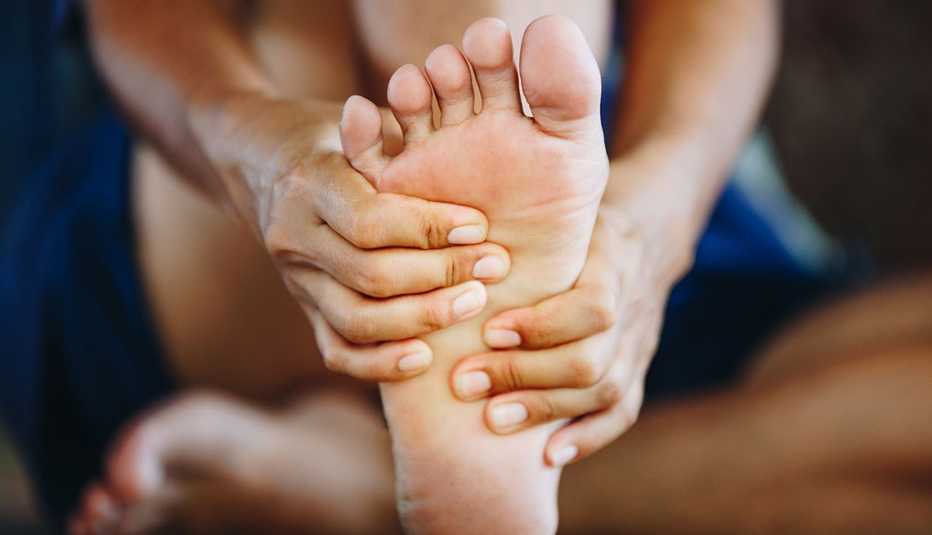Staying Fit
In this story
Integrative medicine • Needle therapy • Chiropractic care • Soft tissue massage • Meditation • Yoga poses
As you age, you may notice that aches and pain — a sore knee, a bum hip — become all too frequent. More than 50 million adults in the United States live with chronic pain, according to the National Institutes of Health. Unfortunately, pain becomes more common as we age: Over a quarter of people between the ages of 45 and 84 report that they currently experience it, according to the Centers for Disease Control and Prevention. Looking for relief, many older adults have tried an alternative therapy. About two-thirds of participants in a new University of Michigan National Poll on Healthy Aging, which was supported by AARP, report that they’ve used an integrative medicine strategy such as acupuncture, chiropractic, massage, meditation or yoga. More than 90 percent said that they found these types of treatments helpful. The poll report is based on findings from an online and phone survey of 2,277 adults ages 50 to 80 conducted in January and February 2022.


AARP Membership— $12 for your first year when you sign up for Automatic Renewal
Get instant access to members-only products and hundreds of discounts, a free second membership, and a subscription to AARP the Magazine.
“Anecdotally, my patients tell me that they benefit from them,” says Rachael Maciasz, M.D., a general internal medicine physician at Michigan Medicine who worked on the report. “It gives them another tool in their toolbox to deal with issues such as chronic pain.” This is especially important as about a third of adults in their 60s and 70s take at least five different prescription drugs and research shows that pain medications are the most frequently prescribed. “These have side effects, especially among older adults,” Maciasz adds. “If we can empower patients to utilize nonpharmacological approaches to their health when it’s appropriate, it’s often safer, and we can cut back on their out-of-pocket costs too.”
But many older adults are paying for their own alternative therapies, the poll found. Only 15 percent of those surveyed said that insurance covered some or all of the cost. So it’s important to research any treatment you’re considering and to talk to your doctor beforehand to make sure it’s right for you, stresses Maciasz. And according to the new survey, that isn’t a common conversation; less than 20 percent of people in the survey said they’d spoken about an integrative health strategy with their primary care provider.
Experts say more quality research needs to be done into alternative, complementary and integrative therapies. The National Center for Complementary and Integrative Health funds such scientific research and chronic pain is one of the areas of study. Just keep in mind that it doesn’t replace traditional medicine, and you always should talk to your doctor before trying any complementary therapy. Here’s a look at five common integrative health treatments used by survey participants: what they are, what the research shows, and whether part — or all — of the cost may be covered by insurance.
1. Acupuncture for pain
What it is: a technique in which a trained practitioner stimulates specific points on your body by inserting needles through your skin. Traditional Chinese medicine believes that the needles open blocked energy channels so that they can flow properly, which encourages healing, says Gary Soffer, M.D., director of the integrative medicine program at the Yale School of Medicine in New Haven, Connecticut. “From a scientific standpoint, there’s less understanding, but we think that your body’s own opiates get released when the needles are placed, which helps to reduce pain,” he explains. Sixteen percent of poll respondents said they’d tried it, according to the AARP survey.
Research shows: It’s effective in treating many different forms of chronic pain, including back, neck and osteoarthritis-related pain such as knee pain, according to the National Institutes of Health. One 2019 review published in the journal Acupuncture in Medicine, for example, analyzed 14 trials of over 2,100 patients with acute or chronic low-back pain and found that those who used acupuncture had significant reductions in discomfort immediately after treatment compared with those who didn’t, or who used sham acupuncture (where needles that look and feel like real acupuncture needles are used but not inserted into the skin.) “Acupuncture can be hard to study, because there’s some evidence that sham acupuncture can help with pain too,” Soffer says.
Is it covered by insurance? Medicare covers up to 12 acupuncture treatments by a licensed acupuncturist over a 90-day period only for chronic low-back pain (defined as pain that lasts for 12 weeks or longer), and an additional eight sessions if you show improvement. You can’t have more than 20 acupuncture treatments during a 12-month period. If you have private insurance, contact the company. Even if it’s not covered, you can use your health savings account or flexible spending account to pay for treatment if it’s recommended by a health care professional for a medical condition.



































































